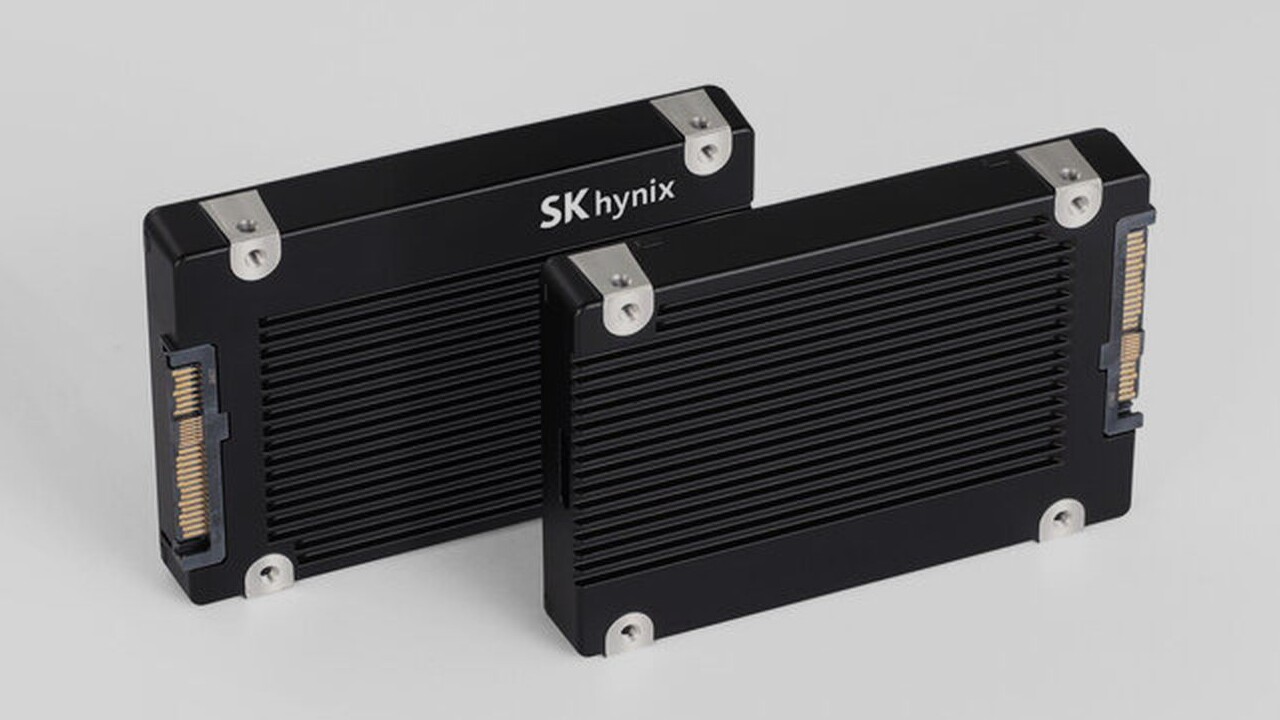IEEE Storage Roadmaps: Quadruple SSD Capacity to Skyrocket for HDDs and Tapes 28 comments
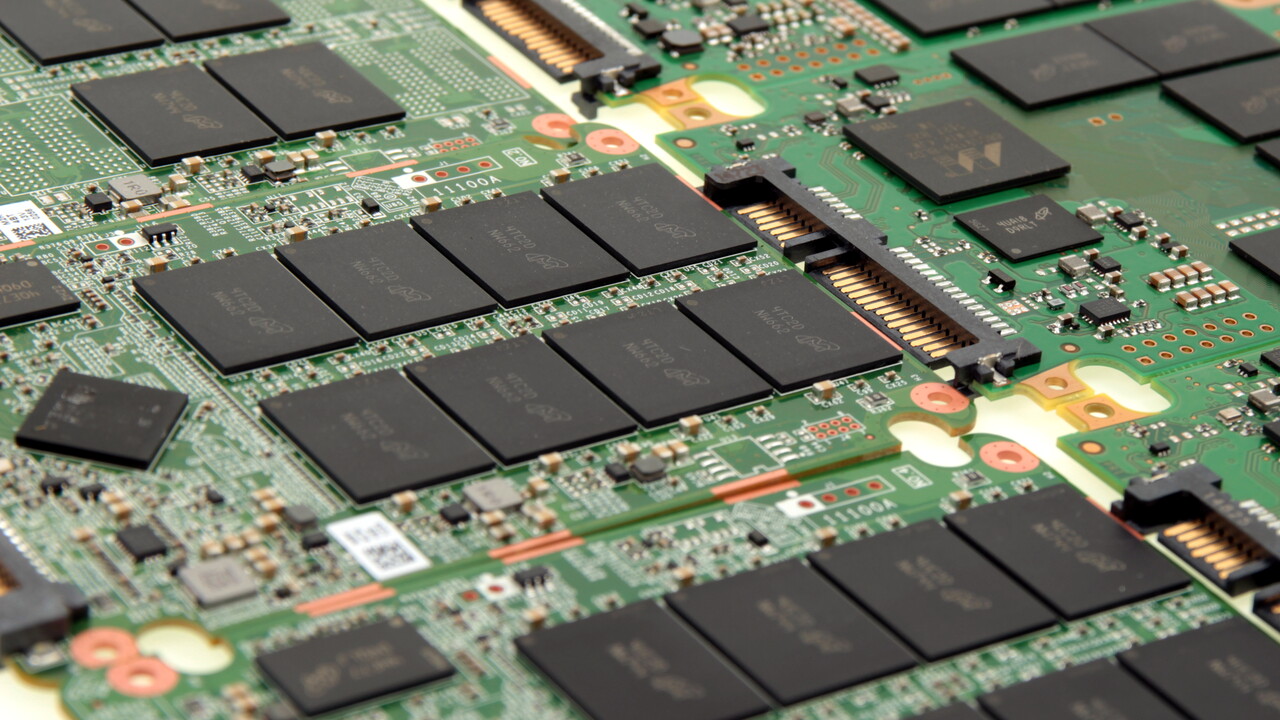
The IEEE trade association has provided forecasts for the future development of mass storage devices such as NAND, HDD, and tape in the form of roadmaps. 3D NAND with 8 Tbits is expected as early as 2029. Sales of hard drives are expected to increase significantly again soon, and tape storage could soon store 1,500 TB per tape.
The IEEE International Roadmap for Devices and Systems Mass Data Storage report examines forecasts for the main storage categories for computer systems. What can we expect in terms of technical development in the coming years and decades? The trade association Institute of Electrical and Electronics Engineers attempts to provide answers to this question in the form of roadmaps.
Representatives from IBM, Kioxia, and Western Digital also contributed to the report, which was written by Tom Coughlin and Roger Hoyt.
8 Tbit NAND Flash Expected in 2029
NAND flash memory has emerged as the most important mass storage device in recent years. In the form of SSDs, they have almost completely replaced mechanical hard disk drives (HDDs) in PCs and are also found in smartphones, memory cards, and USB sticks.
NAND flash has been produced as 3D NAND with superimposed layers of cells for 10 years. The number of layers has been continually increased to accommodate even more bits in the same area. While there were initially 32 layers for MLC chips with 128 GB of storage capacity, the industry has now reached over 200 layers for TLC chips with 1 Tbit of storage volume.
Increasing surface density has reduced the cost per bit. But stacking more and more levels makes production complex. More and more work processes are required, so the cost savings become smaller and smaller. Manufacturers are therefore looking for other ways to further increase storage capacities. This includes the measure of accommodating more bits per memory cell. TLC with 3 bits is currently the common standard. However, 4-bit QLC is becoming more and more widespread and 5-bit per cell PLC is already working at least as a prototype.
 IEEE roadmap for NAND flash to 2029 (Image: IEEE)
IEEE roadmap for NAND flash to 2029 (Image: IEEE)
Kioxia and Western Digital have achieved the highest storage capacity to date, 2 Tbits, with their BiCS8 QLC Flash, which the IEEE roadmap still omits. The association expects the first 4 Tbit NAND chips in 2027 and by 2029 there will be 8 Tbit, which would quadruple the status quo. At least in theory, M.2 SSDs with up to 32 TB instead of the previous 8 TB would be possible. However, because NAND flash is expensive in these sizes, manufacturers will likely use less of it initially for their consumer products.
However, no forecast is made here for the cost of NAND flash per terabyte in five years. The number of cell layers is expected to increase to more than 500 from 2027. A few years ago, Samsung dared to estimate that more than 1,000 layers would be possible by 2030.
Hard drives will experience a real boom
Fewer and fewer hard drives are sold. In 2022, only 166 million units have been sold worldwide, compared to more than 500 million ten years earlier. Although disk storage capacity has increased significantly over this period, the need for this type of mass storage continues to decline. Hard drives hardly play a role in desktops and laptops anymore. Hard drives are still in high demand in storage servers only because of their unbeatable price per terabyte. And new applications requiring high storage requirements, such as AI programs, could even revive sales of mechanical hard drives in the years to come.
By 2028, the IEEE roadmap predicts that more than 200 million hard drives will be sold for the first time. The 2.5-inch format, which is currently only found in external hard drives, will then disappear. Up to 60TB per drive and costs as low as $3.5 per terabyte are expected during this period.
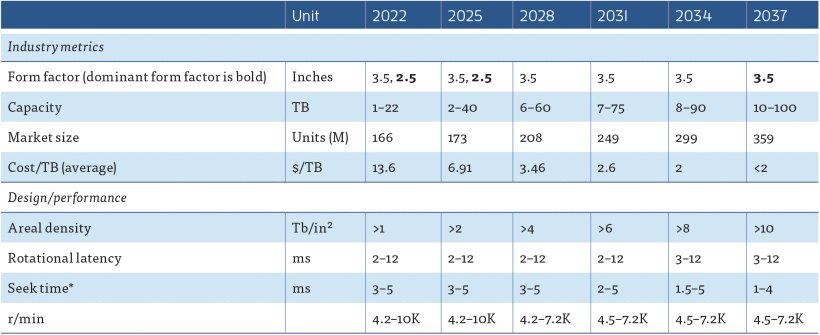 IEEE Roadmap for Hard Disk Drives (HDD) (Image: IEEE)
IEEE Roadmap for Hard Disk Drives (HDD) (Image: IEEE)
By 2037, according to very ambitious and therefore potentially approximate forecasts, sales of hard drives are expected to once again reach more than 350 million units per year. Next, 3.5-inch hard drives are expected to offer up to 100TB of storage volume for less than $200 each. You currently pay over $500 for 24TB hard drives. 30TB hard drives are not yet publicly sold, but are technically feasible.
While technologies such as HAMR and MAMR will continue to increase the area density and therefore the capacity of magnetic disk storage, the predictions of increased performance are sobering. This means that little will change here over the next few decades. Data access remains significantly slower than with SSDs. Thanks to multi-actor technology, at least double flow rates are possible.
Tape Storage Roadmap
The IEEE also confirms that tape storage has a long lifespan. A new sales record was reached just a few years ago.
The maximum storage capacity, currently around 45 TB (compressed), with LTO-9, is expected to reach more than 300 TB by 2031. Tapes of 1,550 TB or 1.55 petabytes are even expected by 2037.
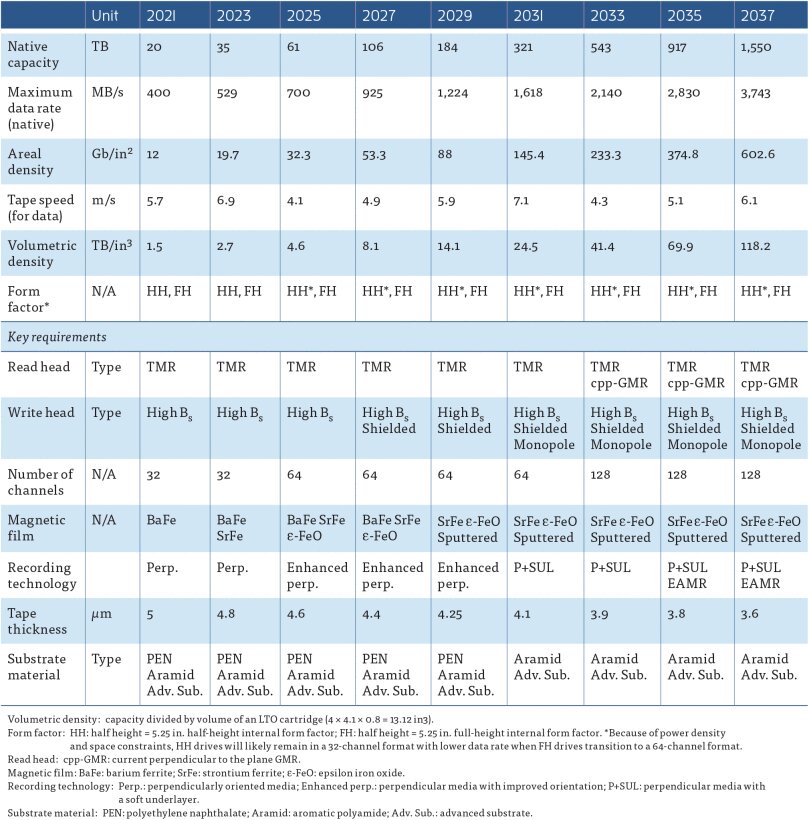 IEEE Roadmap for Tape Storage (Image: IEEE)
IEEE Roadmap for Tape Storage (Image: IEEE)
It’s a good idea to take a look at the regularly updated LTO program roadmap. This provides up to 576 TB uncompressed and up to 1,440 TB for compressed data for the LTO-14 generation, but does not provide any timing information.
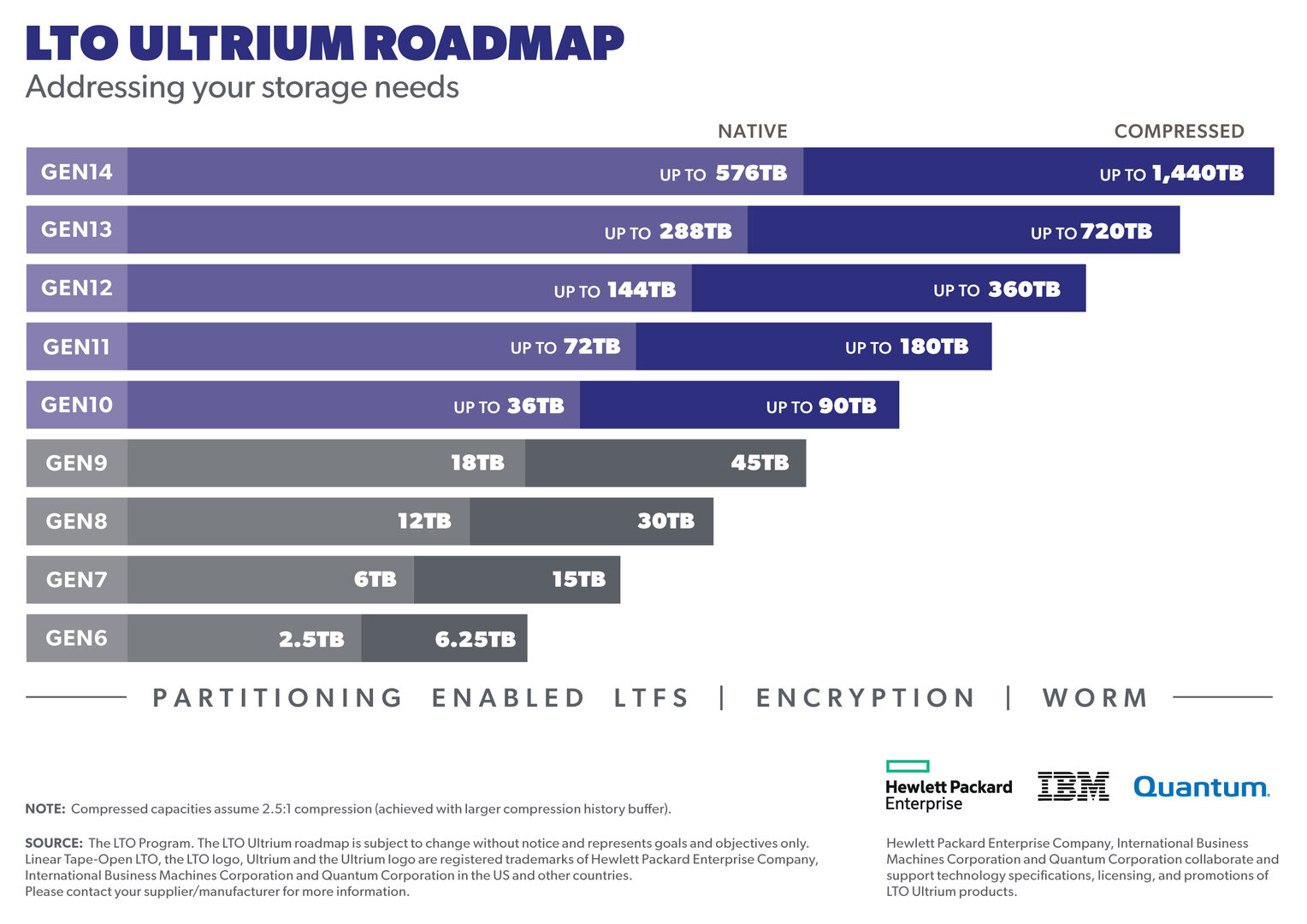 LTO Roadmap 2022 (Image: LTO Program)
LTO Roadmap 2022 (Image: LTO Program)
Roadmap for optical discs
Optical data storage in disk form is also not obsolete. However, the IEEE does not plan any further development for the Blu-ray standard. Around 200 GB of storage capacity with BDXL expansion is the end of the range. Only models up to 128 GB have arrived in the usual stores.
The Archival Disc, developed by Sony and Panasonic, is expected to reach a storage capacity of 1 TB in the coming years and double the maximum data transfer rate to 750 MB/s. With a lower price per terabyte, according to forecasts , it would be superior to BDXL in all important respects.
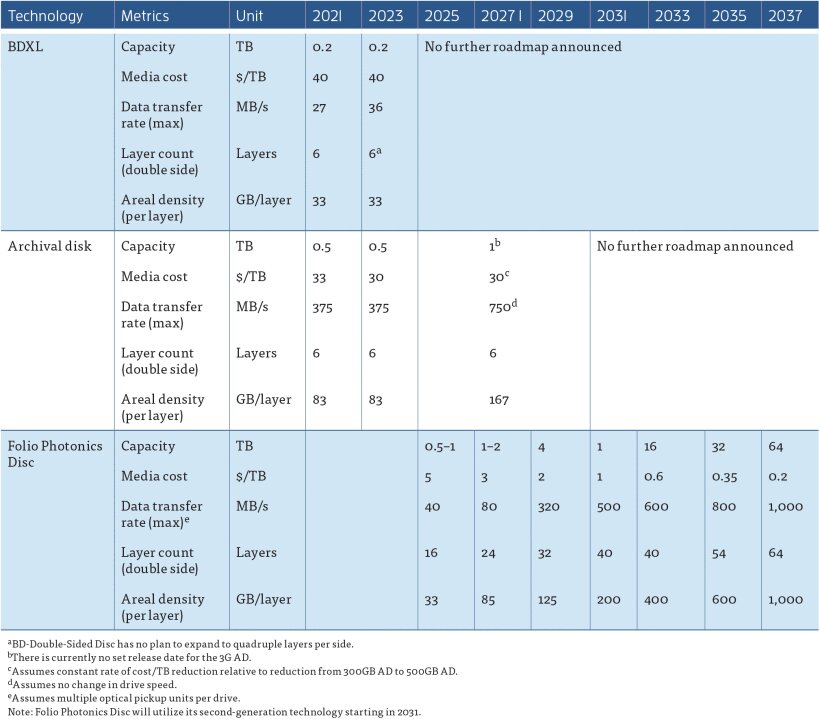 IEEE roadmap for optical data carriers (Image: IEEE)
IEEE roadmap for optical data carriers (Image: IEEE)
The DataFilm Disc (DFD) from startup Folio Photonics is supposed to be even cheaper per terabyte. This is a new long-term archiving technology which, according to current plans, will only be used commercially from 2026. 500 GB to 1 TB of data is initially backed up on 16 layers. By 2037, 64 layers with higher data density are expected to enable a DFD of 64 TB.
The cost per terabyte is currently estimated at $3. As the process progresses, the price per terabyte is expected to fall to less than $1. However, the costs of appropriate training remain high.
Topics: 3D NAND Tape Storage Hard Drives Flash Storage HAMR MAMR Optical Storage Media Storage Technologies SSD Storage Source: IEEE (PDF)

Alice guides you through the best storage solutions, from ultra-fast SSDs to secure cloud options.
